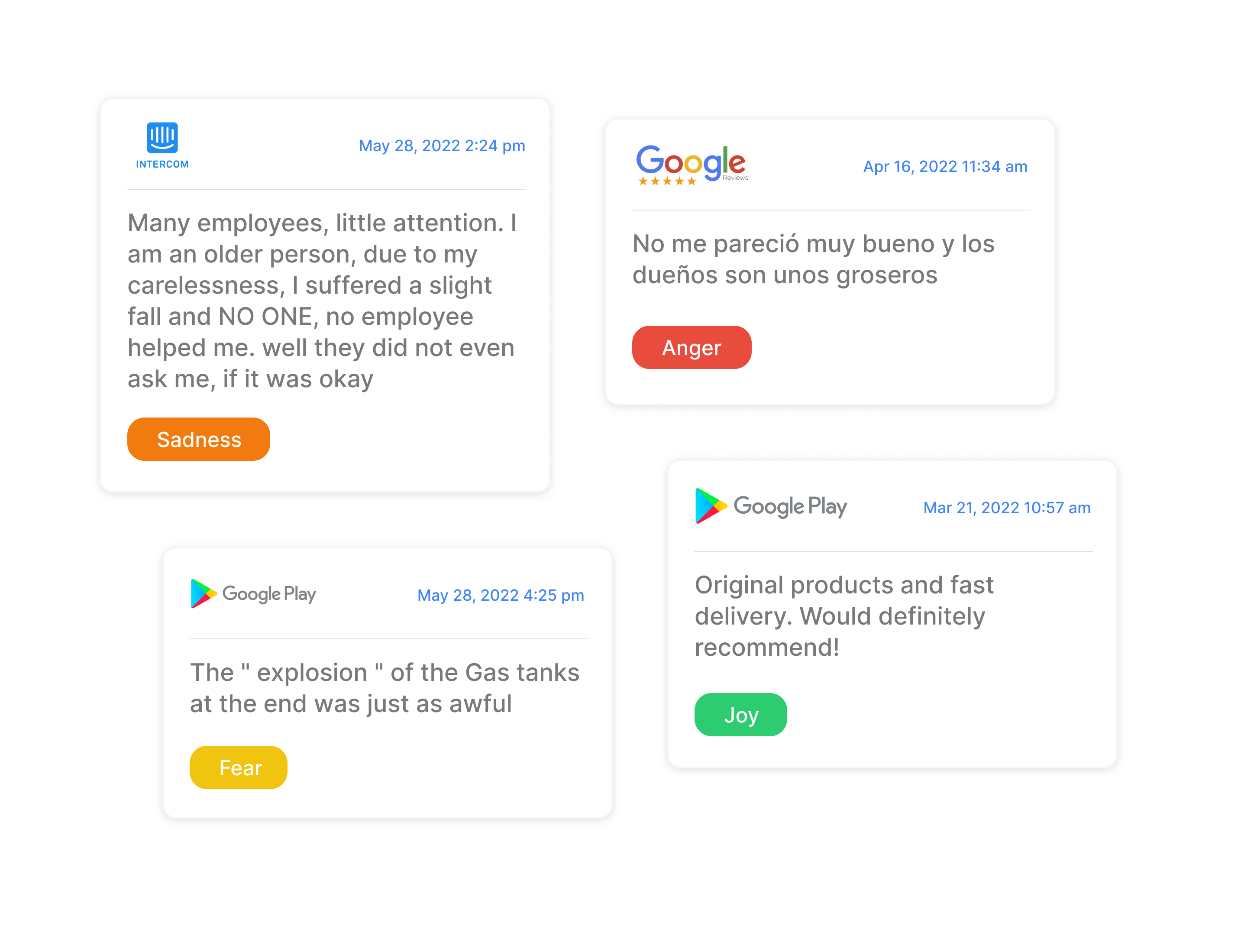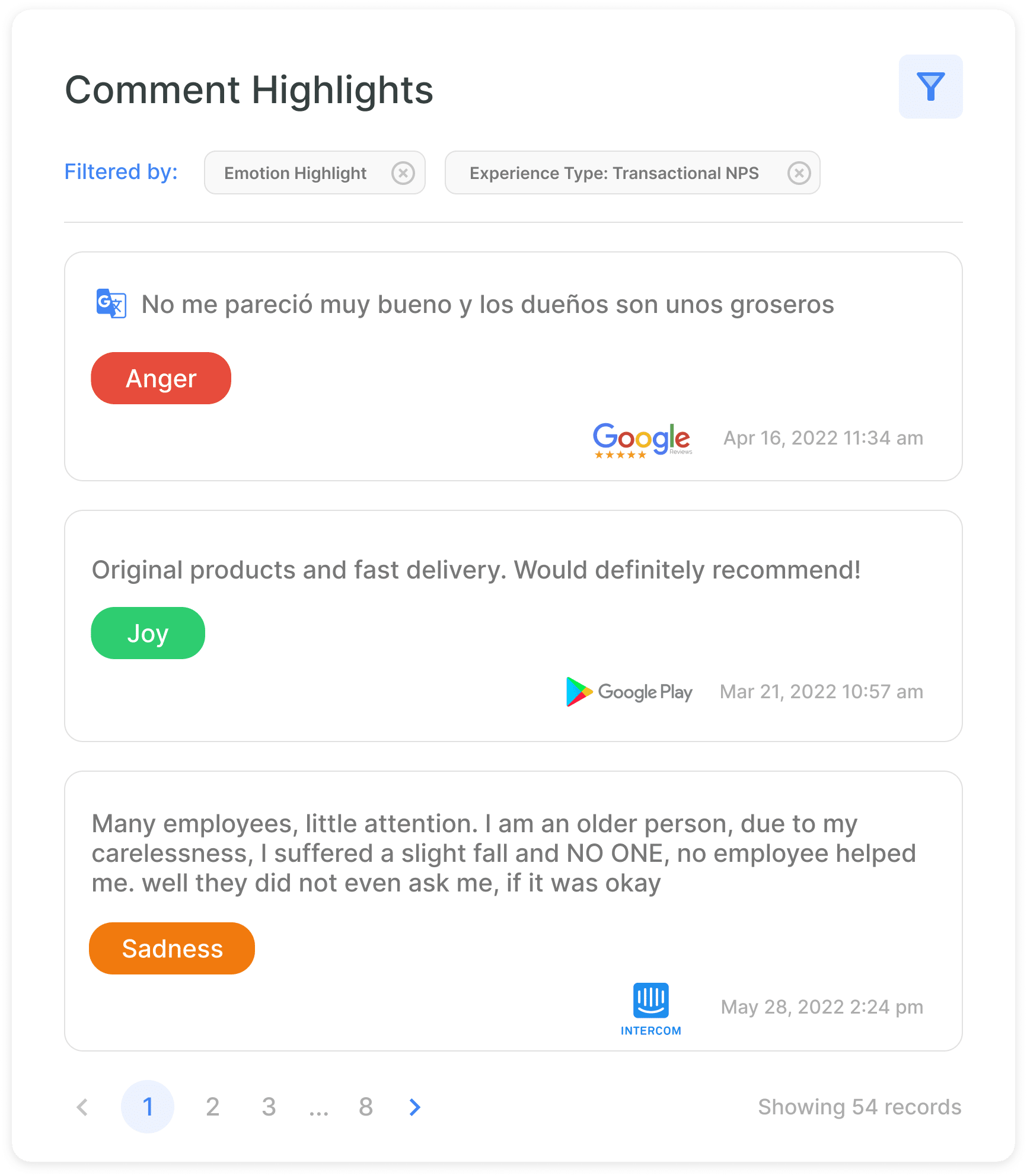Alterna CX’s Emotion Analysis Tool
- 80% accuracy in emotion detection
- Efficient real-time identification of emotions
- Analysis of 7 basic emotions with less manual effort
- Rates effective content of individual words

Request a demo
Why is emotion analysis important?
What are emotion analysis examples?
How does emotion analysis play a role in AI-driven CX management?
How is emotion analysis useful?
How do we help?
How does Alterna CX’s emotion analysis work?
FAQ
What is emotion analysis?
When it comes to analyzing emotions, there are two main schools of thought: emotion analysis and sentiment analysis. Sentiment analysis is concerned with measuring the overall tone of a text or document, usually in terms of positive, negative, or neutral sentiments.
Click to learn more about our sentiment analysis model
Emotion analysis, on the other hand, focuses on identifying and measuring the intensity of discrete emotions, such as happiness, sadness, anger, and fear. It is one of the latest and most exciting applications of artificial intelligence. This process enables us to understand and interpret a text’s emotional content. Emotion analysis from text can be used to gauge public opinion on a certain topic, or to understand how people feel about a product or company. Moreover, understanding negative feedback plays a significant role in customer retention rate: recent studies show that 91% of disgruntled customers will simply leave and never come back.
Why is emotion analysis important?
Emotion analysis software is a powerful tool to adjust today’s changing consumer behavior. “Human” signals, such as emotional text or social media comments, are difficult to analyze and decode, yet these often demand immediate and concentrated customer engagement. Feelings are involved; misinterpretations may occur; cultural barriers may hinder deep insights. Now, more than ever, with increasing screen time and prevailing interactive technologies, people express their feelings on various occasions across platforms. These reactions piling up as loads of complex CX signals become noise. It provides a quick understanding of the consumer’s reactions. It thoroughly examines positive and negative human emotions and sensitivity. This sensitivity highlights the differences in how people express their emotions. As a result, it is a vision and reveals people’s complex feelings and motivations. In short, by examining the motives and desires of customers and users, emotion analysis reveals valuable, accurate information.
What are emotion analysis examples?
Here are some real-world examples across industries and geographies where Alterna CX’s AI-driven emotional customer experience software recognizes the mood of the people from text.
How does emotion analysis play a role in AI-driven CX management?
Emotion analysis using natural language processing (NLP) reduces churn, measures performances of frontend and customer service agents, unlocks upselling and cross selling opportunities. In today’s traditional CX management approach, surveys often fail to reveal the root causes of customer emotional experience and sentiments. In fact, scores may vary based on many outside factors, including geographical bias and industry shocks. These variables make it difficult to perform reliable root-cause analysis using surveys alone. On the other hand, artificial intelligence and machine learning subsist on data. By using out-of-the-box models for text analytics, organizations are able to analyze survey or non-survey data so as not to merely register sentiments, but indeed to understand themes and trends—“emotions”—in customer feedback. Different data acquired this way are synthesized to make a relevant and comparable picture of discernible customer experience.
How is emotion analysis useful?
Here are three cases of Alterna CX’s emotion analysis tool for improving customer loyalty and CX quality:
1. Aligning business policies throughout the organization
Lacking implementation of a solid AI-driven experience management system, a lot of investment and time are necessary to get employees to behave in line with a company’s top goals. Each employee is expected to let previously-defined objectives guide her actions and execution in daily work life. In the long run, finally this discipline becomes the new normal embedded in company culture. For example, zero-tolerance policies against harassment, bullying and discrimination are very hard to adopt throughout the organization to the extent that they resonate in micro-moments. Furthermore, AI-based CX analytics solutions make it happen without delay between comprehension and action. Customer comments registering the feeling “disgust” and “employee behavior with discrimination” can be easily detected in real time with emotion analysis and pre-trained models. The AI-based CX system acts as a round-the-clock analyst, alerting relevant employees to react to particular customers’ negative moods.
2. Detection of personas with the strongest opinions
Emotion analysis can tell CX professionals which customers feel disgusted or angry. For example, this technology can promptly deduce an accurate cause-and-effect understanding of people who are disgusted by niche pricing. Likewise, emotion analysis can help marketers recognize which customers are feeling enough pride or trust to make them potential brand ambassadors.
3. Track customer feelings vs. time
Natural language processing techniques like sentiment analysis and emotion analysis automatically classify trends and achieve high accuracy for identifying the most likely causes. For example, you could see a rise in consumer feelings of “sadness and fear,” then trace those data back to their root cause with a subfield of natural language processing, emotion analysis in real-time.

How do we help?
With our emotion analysis technology, CX professionals can accurately extract what emotions customers or users experience when using products or services every day. Did the specific transaction create “delight” or was it a “disappointing” experience? Is the process “confusing” or does it “work like a charm”?
Traditionally, CX professionals use sentiment analysis to understand whether an experience was positive or negative. Applying this approach, however, it is not possible to differentiate between a moderately happy customer comment and that of a delighted customer or, conversely, a slightly disappointing user comment versus a very angry user comment. The tool bridges this gap by enabling a granular look at customer emotions for better experience analysis and design.
Alterna CX also combines metric-based experience data such as Customer Effort Score or Net Promoter Score with emotion models. This machine learning algorithm enables CX professionals to analyze the effects of key human emotions on decisive business metrics such as NPS, retention, and revenue.
How does Alterna CX’s emotion analysis work?
Our emotion model scans through text-based data created by customers in surveys, complaints, social or service. Inspired by Dr. Robert Plutchik’s emotional wheel study of the seven most frequently felt human emotions (joy, trust, fear, surprise, sadness, anger, and disgust), our engineering team developed this AI-based advanced text analytics technology. Our emotion analysis from text is ready to use but also flexible enough so that “custom emotions” may be trained as required for specific company needs.
By evaluating emotions in real time, CX professionals can identify the problems, opportunities and issues that contribute the most to CX quality and customer loyalty, prioritize improvement decisions accordingly, and initiate action in the form of an immediate fix, a re-design, or another type of improvement.
FAQ
Can AI understand emotions?
This tool gives us the ability to understand and interpret the emotional content of the text. Emotion analysis technology can be used to gauge public opinion on a certain topic, or to understand how people feel about a product or company. Alterna CX’s AI-based software can detect emotions such as joy, anger, disgust, happiness.
How to analyze emotions?
Our emotion model scans through text-based data created by customers in surveys, complaints, social or service. Inspired by Dr. Robert Plutchik’s emotional wheel study of the seven most frequently felt human emotions (joy, trust, fear, surprise, sadness, anger, and disgust), our engineering team developed this AI-based advanced text analytics technology. Our emotion analysis from text is flexible enough so that “custom emotions” may be trained as required for specific company needs. By evaluating emotions in real time, CX professionals can identify the problems, opportunities and issues that contribute the most to CX quality and customer loyalty, prioritize improvement decisions accordingly, and initiate action in the form of an immediate fix, a re-design, or another type of improvement.
Request a Demo
Seeing is believing
Learn how to apply AI to analyze all the various CX ”signals” generated by your customers via surveys, text, complaints, social media, and other interactions. Discover how to quickly identify and flag the most important problems and opportunities, and then better prioritize your investments.












